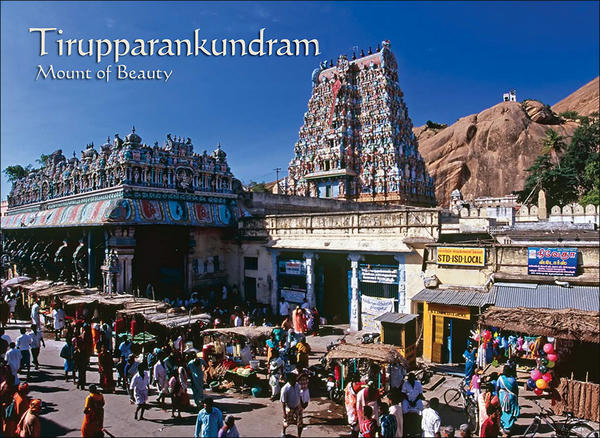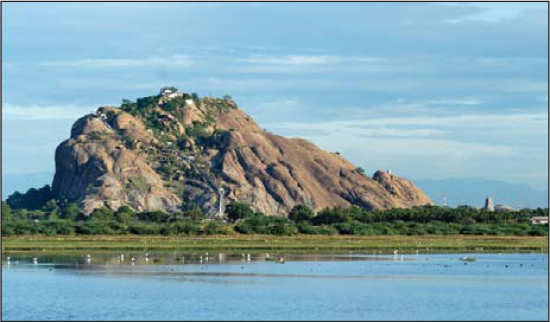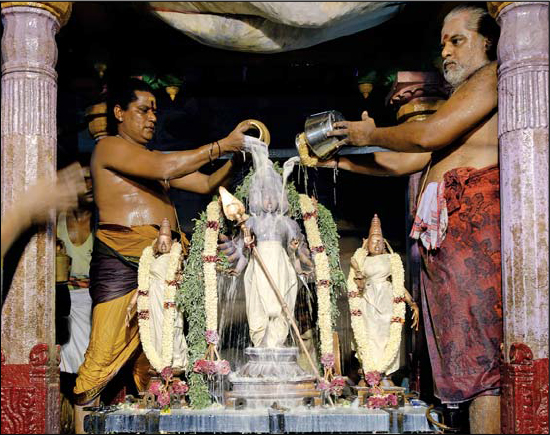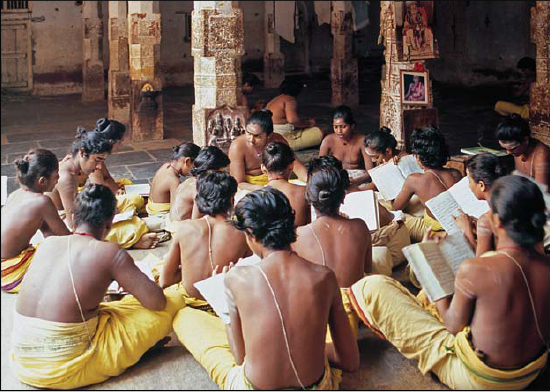

The temple entrance bustles with devotees
• • • • • • • • • • •§
 HE DEVOTEE IN SEARCH OF LORD MURUGAN’S GRACE BEGINS the fortnight-long six-temple pilgrimage at Madurai, the famous temple city, an ancient capital of the Pandya kings and hub of South Indian art, literature, architecture and sculpture for millennia. This “Athens of the Orient” was the seat of the Tamil Sangams, producing some of the finest philosophical treatises and exquisite, heart-melting devotional poetry during a golden age of Tamil civilization.§
HE DEVOTEE IN SEARCH OF LORD MURUGAN’S GRACE BEGINS the fortnight-long six-temple pilgrimage at Madurai, the famous temple city, an ancient capital of the Pandya kings and hub of South Indian art, literature, architecture and sculpture for millennia. This “Athens of the Orient” was the seat of the Tamil Sangams, producing some of the finest philosophical treatises and exquisite, heart-melting devotional poetry during a golden age of Tamil civilization.§
We arrive in Madurai via a short flight from Chennai, though it is more common to travel the 460 kilometers by overnight train or bus. Driving north into the city from Madurai’s modest airport, the pilgrim is blessed with the sight of Tirupparankundram to the West. This hill, easily seen perched 550 feet above the otherwise flat landscape, is a massive granite rock at which Lord Murugan’s first encampment is situated.§
Madurai is given life by the famous Meenakshi-Sundareshvara temple, which lies at its center. This vast citadel, rebuilt by the Nayak kings between the mid-sixteenth and mid-seventeenth centuries, thrives with the constant bustle of hundreds of thousands of worshipers every day. Lodgings of all grades are abundant in the city, most of them located conveniently near the temple.§

ALL PHOTOS: M. AMIRTHAM/DINODIA§
Holy hill: Tirupparankundram hillock with the temple at its base; the entrance tower can be seen at right
• • • • • • • • • • •§
Traditionally, the devotee visits a Ganesha shrine at the inception of the arupadaiveedu pilgrimage. Our Gurudeva advised going to the massive, obstacle-removing Ganesha, called Mukkuruni Vinayagar, inside the Meenakshi-Sundareshvara temple itself. So, after getting settled, we depart for the east entrance of Madurai’s massive temple complex.§
Resolving to follow the strictest protocol on our yatra, we go only to the temple’s Ganesha shrine, respectfully resisting the powerful pull to have darshan at the main Siva and Shakti shrines. From this moment on, until the pilgrimage is complete, we will visit no temples or shrines other than the six prescribed Murugan temples. Proceeding to the kodimaram (flagpole) and turning right before the main shrine, we wend our way through the labyrinthine complex and soon stand before the ten-foot-tall murti of Mukkuruni Vinayagar. The priest attending the shrine performs a short arati on our behalf. This is a quiet area, and devotees nearby are meditating on the Lord of Obstacles. Sitting with eyes closed, we beseech His inner assistance with the sacred trek we are about to undertake to His brother’s abodes. Sounds of all kinds overwhelm our ears: priests chanting, bells ringing, votaries singing, children playing and the shuffling feet of countless devotees streaming by as they move from shrine to shrine for darshan.§
If with piety and merit of former birth thou doth aspire to the goal of liberation, strive for the wisdom that radiates from virtuous deeds, and may yearning sweet for His roseate feet animate thy mind and lead thee to attainment divine.§
TIRUMURUGARRUPADAI, LINES 62–67§

Agamic worship: Priests perform daily abhishekam to the festival Deity of Arumugam, Lord Murugan with six faces§

Boys learn ancient mantras from the Vedas and Agamas at the priest training school, pathashala, located in the temple precincts
• • • • • • • • • • •§
The first day of our pilgrimage now complete, Lord Murugan’s first abode is on our minds’ horizon. Arising early the next morning, we drive just seven kilometers southwest to Tirupparankundram, a large hill and favorite resort of Murugan, extolled as a mount of beauty in Saint Nakkirar’s poem. In fact, this is where the poet wrote his famous hymn. Ratna Navaratnam tells us in Karttikeya, The Divine Child, “The beautiful setting of this hill with its lotus ponds, trailing carpets of flowers and swarms of bees and water fronts are described in Tirumurugarrupadai,” which in Tamil means “Holy Guide to Lord Murugan.”§
The Tirupparankundram Arulmigu Sri Subrahmanya Swami Tirukkoyil lies at the foot of the hill, on the north side. Entering the temple through the tall, ornately carved and colorful gopuram, we ascend steps leading through pillared halls, rich with sculpture and art, a windfall of being near the central hub of Madurai. We chose Markali, the holiest month of the Tamil calendar, for our pilgrimage. This is the same time when Ayyappaswami devotees from across South India perform their annual yatra to Sabarimalai in Kerala. Many of them follow the strict practice of paying their respects at every temple along the way, so this popular temple is brimming with excited, black- and orange-clad followers of Ayyappaswami.§
The entire cave-like shrine, including the murtis, is carved right out of the side of the granite hill. The temple precincts grow tighter and tighter as devotees ascend toward the inner sanctum. Squeezing together with hundreds of others, winding their way through a maze of metal railings designed to keep everyone flowing along in an organized fashion, worshipers arrive at the inner sanctum. We experience an odd juxtaposition of nearness and swiftness in this process. Moving single-file past the shrine, we find ourselves a few feet from Lord Murugan—and for a mere moment, we can almost reach out and touch Him.§

ART BY A. MANIVEL§
Enshrined Deity: An artist’s rendition of the temple’s Murugan sanctum
• • • • • • • • • • •§
Murugan is known as Subrahmanya Swami at Tirupparankundram. Our guide, a boy who attends the temple’s pathashala, explains that this is the famed site where, according to legend, Murugan married Devayanai after defeating the demon Surapadman. This marriage symbolizes the devotee’s uniting with God after transcending his own lower nature. The rock-cut shrine depicts the story of the procession of Gods, seers, men and animals who came to this mount to witness the mystical wedding. Holding His vel, or lance, Murugan is enshrined with Devayanai at His side, as well as Sage Narada, who performed the wedding. Above are the Sun and Moon; below are goats, cocks, elephants and peacocks. There are shrines on either side for Karpaga Vinayagar, Durga, Sivalingam, Perumal (Vishnu), as well as Saint Nakkirar. We are surprised to find that Durga’s shrine is the center-most, intimating that it could have been the original sanctum of the temple.§
Our guide informs us that in Murugan’s shrine abhishekam is not performed to the main rock-hewn murti, but only to His silver vel. In honor of our visit, the head priest takes hold of Murugan’s vel and performs a brief but powerful abhishekam to it with milk and vibhuti, or holy ash, and then deftly packages the ash and gives it to us to take away as prasadam. Descending the steps as quickly as we came up, we discover a small, pillared hall off to the side that is a perfect place to sit and meditate a while before leaving.§
What was initiated here will grow and blossom through the rest of the pilgrimage. The experience burns deeply into our souls, but little prepares us for what we are to experience at Murugan’s seaside abode.§